NOx Emission of a Correlation between the PEMS and SEMS over Different Test Modes and Real Driving Emission
Abstract
:1. Introduction
2. Experimental Method
2.1. Chassis Dynamometer and Exhaust Emission Analysis System
2.2. Various Test Modes in Laboratory
2.2.1. Test Vehicle and After-Treatment System
2.2.2. RDE Route
2.3. Test Equipment
2.3.1. The PEMS Equipment
2.3.2. The SEMS Equipment
2.3.3. Principles of the PEMS and SEMS Equipment
2.4. Reliability Verification of Data Measured by the PEMS Equipment
2.5. Reliability Verification of Data Measured by the SEMS Equipment
- : the mass of the exhaust component “gas”;
- : the density of the exhaust component “gas”;
- : the concentration of the exhaust component “gas”;
- : the exhaust mass flow rate.
3. Results
3.1. Correlation of NOx Emissions between the PEMS and SEMS Equipment in Laboratory
3.2. Detailed Analysis on Real-Time Profiles of NOx Emissions for Characteristics of the NOx Conversion in Laboratory
NO + CO/HC → N2 + CO2/H2O
NO2 + CO/HC → N2 + CO2/H2O
3.3. Correlation of NOx Emissions between the PEMS and SEMS Equipment On-Road
3.4. Detailed Analysis on Real-Time Profiles of NOx Emissions for the Characteristics of the NOx Conversion On-Road
4. Conclusions
- The slope was significantly equal to 1, and the coefficient of determination was 0.93 or more when comparing between the vehicle speed and exhaust flow rate measured by the PEMS and SEMS equipment. It was possible to verify the reliability of the OBD data measured by the SEMS equipment.
- Via the correlation test results of PEMS and SEMS equipment in the laboratory, most of the NOx emissions measured by the PEMS and SEMS equipment were within the current NOx emission limit (0.08 g/km). It was verified that the slope of the NOx emissions measured by the PEMS and SEMS equipment was significantly close to 1, and the coefficient of determination was 0.961, thus indicating that the results were highly similar.
- Regarding the on-road results of the PEMS and SEMS equipment obtained from the correlation tests, most of the test results were within the RDE NOx emissions limit (0.1144 g/km). It was confirmed that the slope of the NOx emissions measured by the PEMS and SEMS equipment was 0.816, which is lower than the slope obtained via the correlation test in the laboratory. In addition, the coefficient of determination was 0.922, thus indicating that the results were highly similar.
- However, NOx emissions measured by the SEMS equipment were higher than those measured by the PEMS equipment under RDE tests. When NOx emissions increase due to LNT regeneration and the SCR efficiency reduction, the SEMS equipment increases NOx emissions by exceeding the limit of the O2 measurement range.
- Finally, when comparing the two equipment types, the PEMS and SEMS equipment can be used interchangeably in the same way for measuring NOx emissions. However, unlike the PEMS equipment, the SEMS equipment can measure NO emissions generated by urea solution. Therefore, it is necessary to install an additional NH3 sensor for comparative analysis.
Author Contributions
Funding
Institutional Review Board Statement
Informed Consent Statement
Data Availability Statement
Acknowledgments
Conflicts of Interest
References
- Lee, D.I.; Yu, Y.S.; Chon, M.S.; Cha, J. A Study of Cold-start and Evaluation Method for Real Driving Emissions of Diesel Light-duty Vehicle. Trans. Korean Soc. Automot. Eng. 2019, 27, 199–206. [Google Scholar] [CrossRef]
- Thompson, G.J.; Carder, D.K.; Besch, M.C.; Thiruvengadam, A.; Kappanna, H.K. In-Use Emissions Testing of Light-Duty Diesel Vehicles in the United States; West Virginia University: Morgantown, WV, USA, 2014. [Google Scholar]
- Yu, Y.S.; Chon, M.S.; Cha, J. NOx Characteristics of the Real Driving Emission with Data Calculation Methods. Alex. Eng. J. under review.
- European Commission. Amending Regulation (EC) No 692/2008 as Regards Emissions from Light Passenger and Commercial Vehicles (Euro 6); Regulation (EU) 2016/646; European Union: Luxembourg, 2016. [Google Scholar]
- Vermeulen, R.J.; van Goethem, S.; Baarbe, H.L.; Zuidgeest, L.W.M.; Spreeen, J.S.; Vonk, W.A. SEMS operating as a proven system for screening real-world NOx and NH3 emissions. In Proceedings of the 20th International Transport and Air Pollution Conference, Graz, Austria, 18–19 September 2014. TAP paper 58. [Google Scholar]
- Kadijk, G.; Vermeulen, R.J.; Buskermolen, E.G.; Elstgeest, M.; van Heesen, D.; Heijne, V.A.M.; Ligerink, N.E.; van der Mark, P.J. NOx Emissions of Eighteen Diesel Light Commercial Vehicles: Results of the Dutch Light-Duty Road Vehicle Emission Testing Programme 2017; TNO: The Hague, The Netherlands, 2017. [Google Scholar]
- Kadijk, G.; Elstgeest, M.; Ligterink, N.E.; van der Mark, P.J. Emissions of Twelve Petrol Vehicles with High Mileages; TNO: The Hague, The Netherlands, 2018. [Google Scholar]
- Sjödin, Å.; Borken-Kleefeld, J.; Carslaw, D.; Tate, J.; Alt, G.-M.; Fuente, J.D.; Bernard, Y.; Tietge, U.; McClintock, P.; Gentala, R.; et al. Real-Driving Emissions from Diesel Passenger Cars Measured by Remote Sensing and as Compared with PEMS and Chassis Dynamometer Measurements—CONOX Task 2 Report; IVL Swedish Environmental Research Institute: Stockholm, Sweden, 2018. [Google Scholar]
- Lee, B.; Yun, B.; Jung, J.; Kim, D. Study on NOx Emission Characteristics of Diesel Light Duty Vehicles by Analyzing Massive Driving Data. Trans. Korean Soc. Automot. Eng. 2018, 26, 684–692. [Google Scholar] [CrossRef]
- Yu, Y.S.; Jeong, J.W.; Kim, S.L.; Sim, I.; Chon, M.S.; Cha, J. A Study Correlations of NOx Emissions between PEMS and SEMS of Light-Duty Diesel Vehicle in Real Driving According to Ambient Temperature and Cold Start. Trans. Korean Soc. Automot. Eng. 2020, 28, 277–283. [Google Scholar] [CrossRef]
- Yang, J.; Durbin, T.D.; Jiang, Y.; Tange, T.; Karavalakis, G.; Cocker, D.R.; Johnson, K.C. A comparison of a mini-PEMS and a 1065 compliant PEMS for on-road gaseous and particulate emissions from a light duty diesel truch. Sci. Total Environ. 2018, 640–641, 364–376. [Google Scholar] [CrossRef] [PubMed] [Green Version]
- Vermeulen, R.J.; Ligterink, N.E.; Vonk, W.A.; Baarbe, H.L. A smart and robust NOx emission evaluation tool for the environmental screening of heavy-duty vehicles. In Proceedings of the 19th International Transport and Air Pollution Conference, Thessaloniki, Greece, 26–27 November 2012. [Google Scholar]
- Ligterink, N.E.; Heijne, V.; Kadijk, G.; van der Mark, P.J.; Spreen, J.; Stelwagen, U. NOx Emissions of Fifteen Euro 6 Diesel Cars: Results of the Dutch LD Road Vehicle Emission Testing Programme 2016; TNO: The Hague, The Netherlands, 2016. [Google Scholar]
- Heepen, F.; Weilin, Y. SEMS for Individual Trip Reports and Long-Time Measurement; SAE Technical Paper Series; SAE International: Warrendale, PA, USA, 2019. [Google Scholar]
- Vermeulen, R.J.; van Gijlswijk, R.N.; van Goethem, S. NOx emissions of Heavy-Duty Vehicles with Euro VI Certified engines. In Proceedings of the Transport and Air Pollution Conference, Thessaloniki, Greece, 15–17 May 2019. [Google Scholar]
- Ko, K.-H.; Choi, S.-C. A study on the improvement of vehicle fuel economy by fuel-cut driving. J. Korea Acad. Ind. Coop. Soc. 2012, 13, 498–503. [Google Scholar]
- Sahner, K. Automotive Exhaust Gas Sensing—Current Trends. In Proceedings of the 14th International Meeting on Chemical Sensors—IMCS 2012, Nürnberg/Nuremberg, Germany, 20–23 May 2012; AMA-Science: Berlin, Germany, 2012. [Google Scholar]
- Kato, N.; Nakagaki, K.; Ina, N. Thick Film ZrO2 NOx Sensor; SAE Technical Paper Series; SAE International: Warrendale, PA, USA, 1996. [Google Scholar]
- Lee, D.I.; Yu, Y.S.; Park, J.; Chon, M.S.; Cha, J. NOx Conversion Efficiency of SCR Diesel Vehicle Under Cold Start Condition. J. ILASS-Korea 2018, 23, 244–253. [Google Scholar]
- Bertoa, R.S.; Astorga, C. Impact of cold temperature on Euro 6 passenger car emissions. Environ. Pollut. 2018, 234, 318–329. [Google Scholar] [CrossRef] [PubMed]
- Maurer, M.; Fortner, T.; Holler, P.; Zarl, S.; Eichlseder, H. Impact of cyclic lean-rich aging under DeSOx condition on the lean-gas light-off and hydrogen formation ability of a lean NOx trap (LNT). Automot. Engine Technol. 2017, 2, 63–77. [Google Scholar] [CrossRef] [Green Version]
- Bari, S. Chapter 7: NOx Storage and Reduction for Diesel Engine Exhaust Aftertreatment. In Diesel Engine: Combustion, Emissions and Condition Monitoring; Bari, S., Ed.; IntechOpen: Adelaide, Australia, 2013; pp. 161–196. [Google Scholar]
- Pereda-Ayo, B.; González-Velasco, J.R.; Burch, R.; Hardacre, C.; Chansai, S. Regeneration mechanism of a Lean NOx Trap (LNT) catalyst in the presence of NO investigated using isotope labelling techniques. J. Catal. 2012, 285, 177–186. [Google Scholar] [CrossRef]
- Jang, W. Evaluation of Nitrogen Oxides (NOx) Emission and Its After-Treatment System Performance Characteristics from Diesel Passenger Vehicles on Real-World Driving with Ambient Temperature Effects. Ph.D. Thesis, Korea University, Seoul, Korea, February 2017. [Google Scholar]
- Nova, I.; Tronconi, E. Urea-SCR Technology for deNOx After Treatment of Diesel Exhausts, 1st ed.; Springer: New York, NY, USA, 2014; pp. 1–716. [Google Scholar]
- Fedoseev, G.; Loppolo, S.; Zhao, D.; Lamberts, T.; Linnartz, H. Low Temperature Surface Formation of NH3 and HNCO: Hydrogenation of nitrogen atoms in CO-rich interstellar ice analogues. Mon. Not. R. Astron. Soc. 2015, 446, 439–448. [Google Scholar] [CrossRef] [Green Version]
- Gibbs, J.; Singh, G. Innovative SCR Materials and Systems for Low Temperature Aftertreatment, U.S. Annual Merit Review and Peer Evaluation Meeting (AMR); Department of Energy, Vehicle Technologies Office: Washington, DC, USA, 2017.
- Jeong, J.W.; Sim, I.; Kim, S.L.; Yu, Y.S.; Chon, M.S.; Cha, J. A Correlation Analysis of NOx Emissions for Driving Condition between PEMS and SEMS Devices. Trans. Korean Soc. Automot. Eng. 2021, 29, 187–196. [Google Scholar] [CrossRef]
- Aliramezani, M.; Koch, C.R.; Secanell, M.; Hayes, R.E.; Patrick, R. An electrochemical model of an amperometric NOx sensor. Sens. Actuators B Chem. 2019, 290, 302–311. [Google Scholar] [CrossRef]
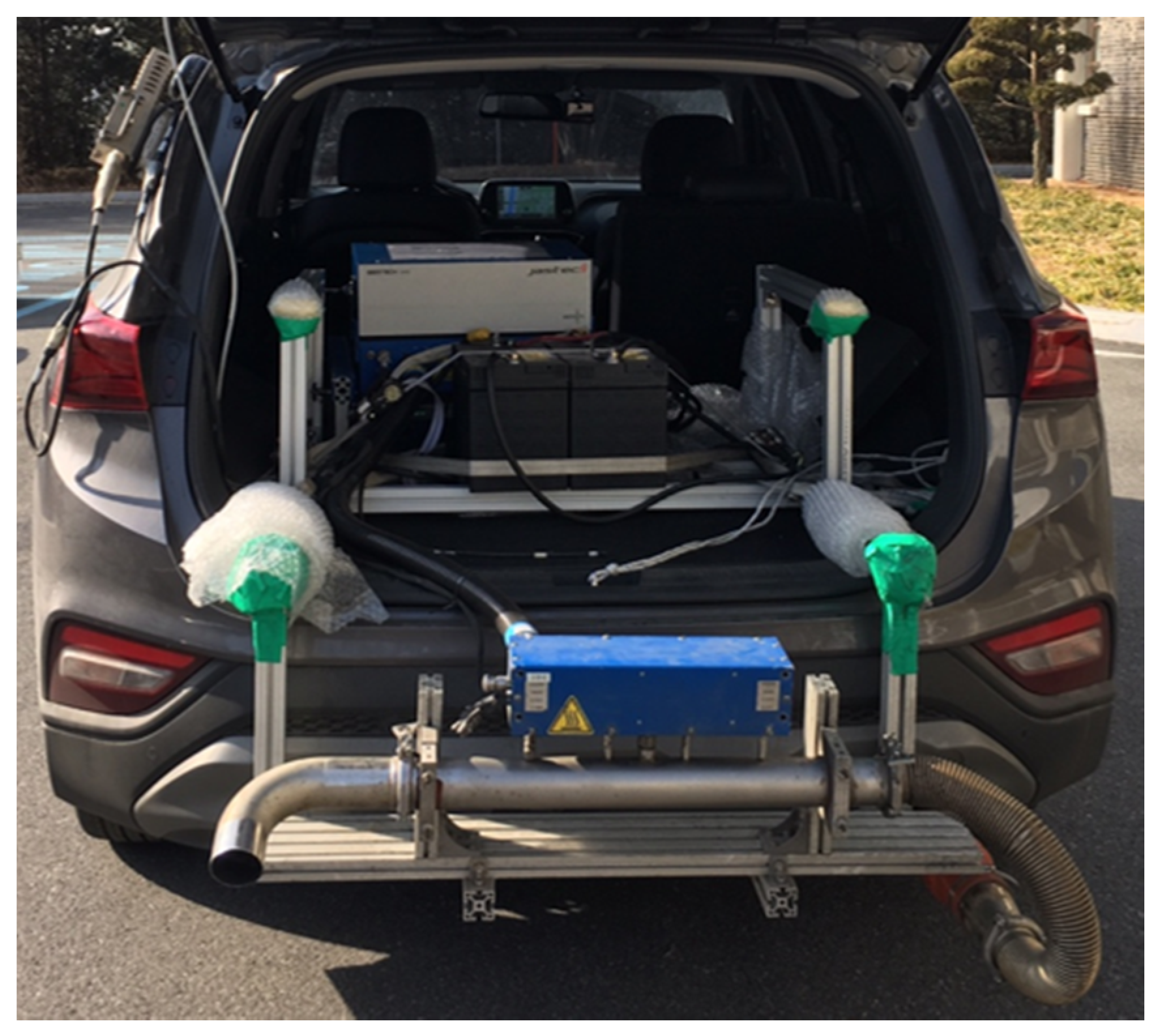
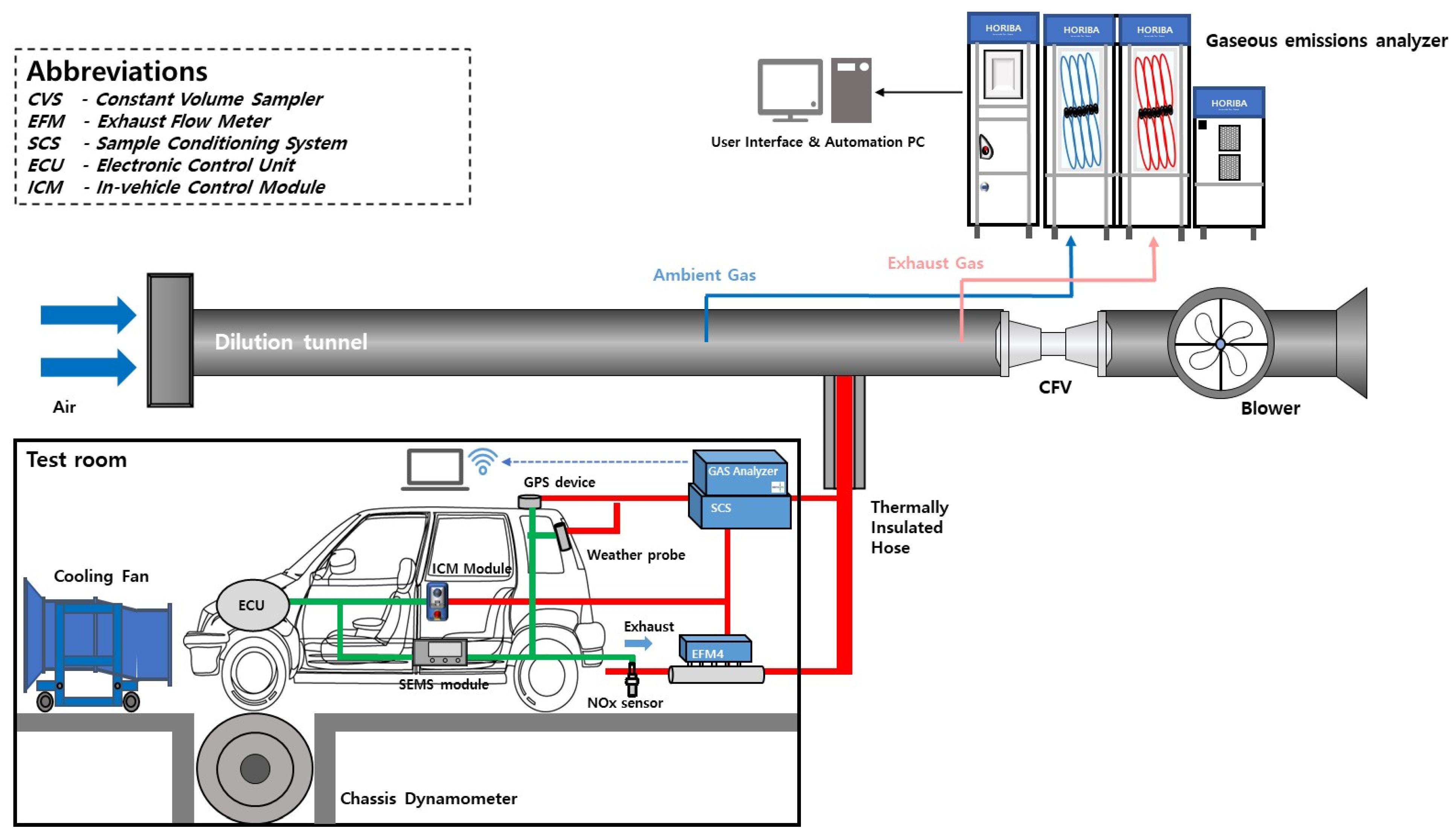
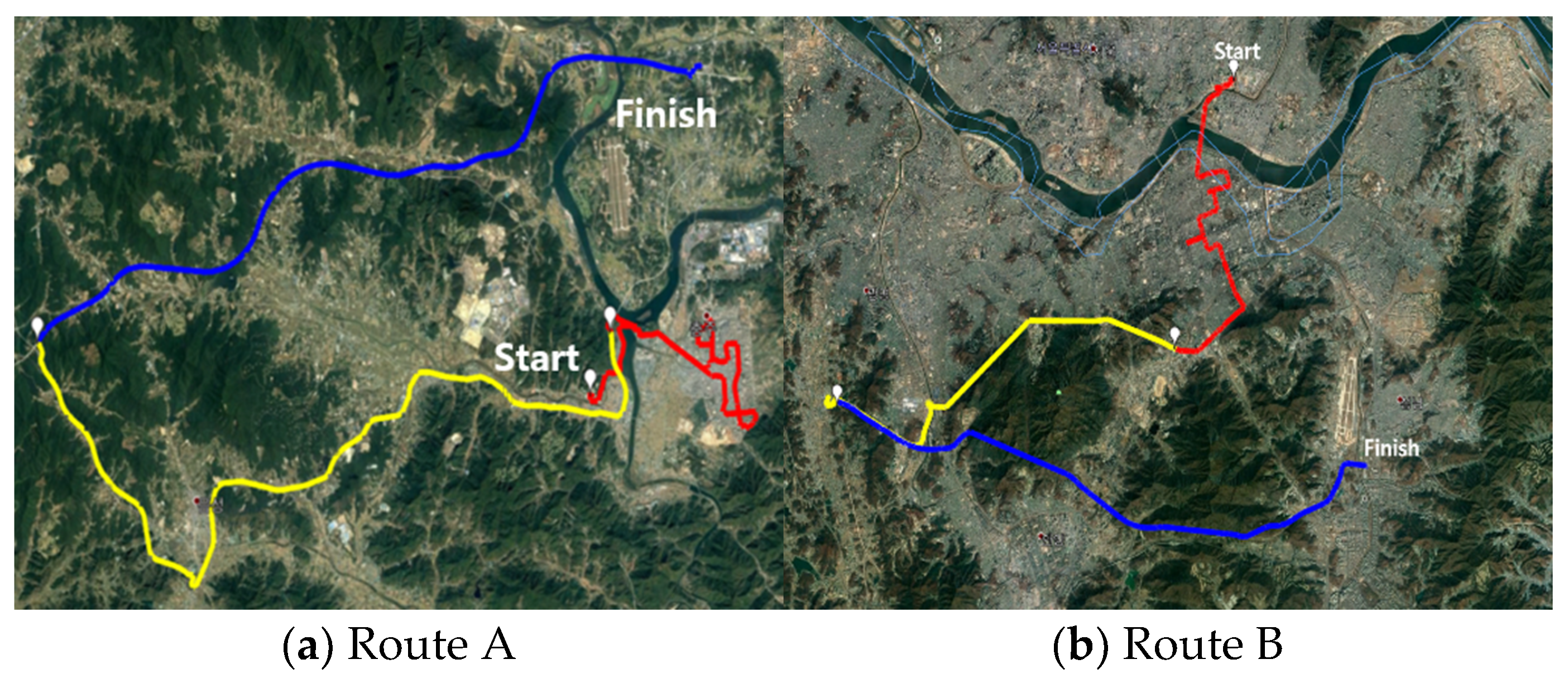


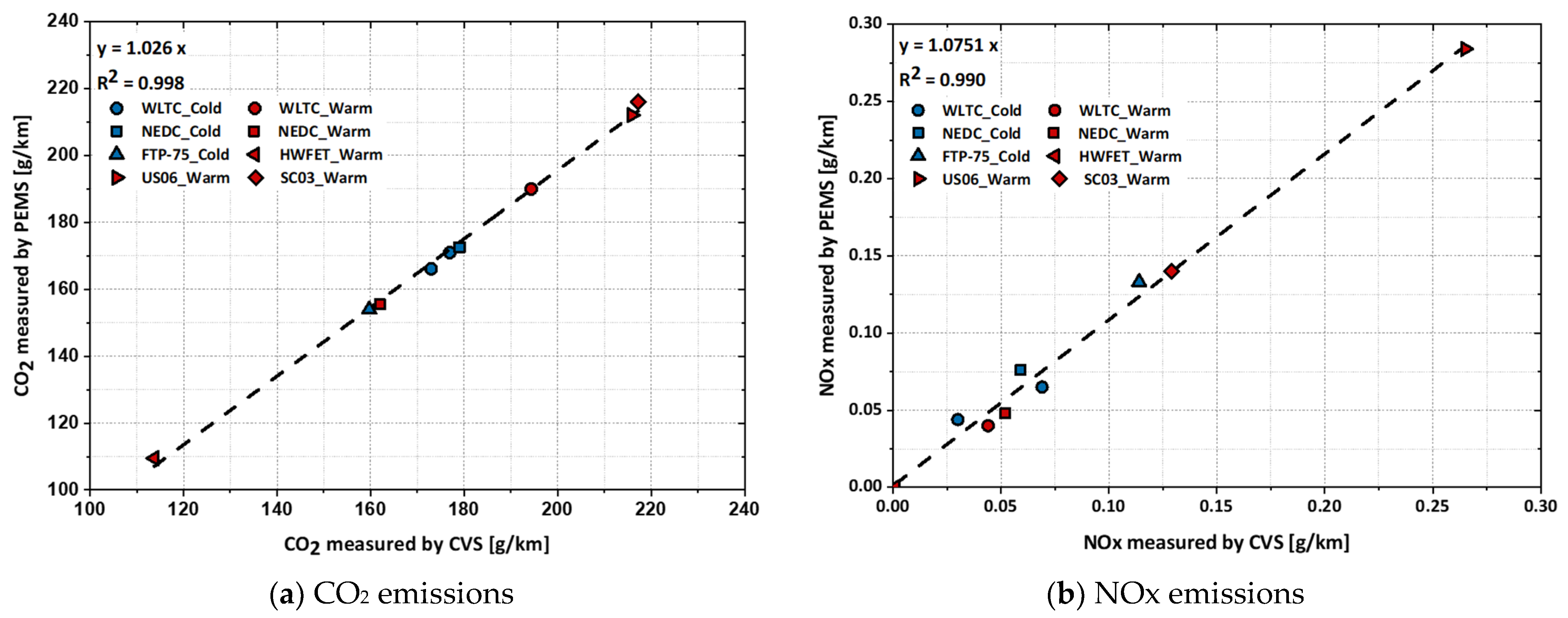

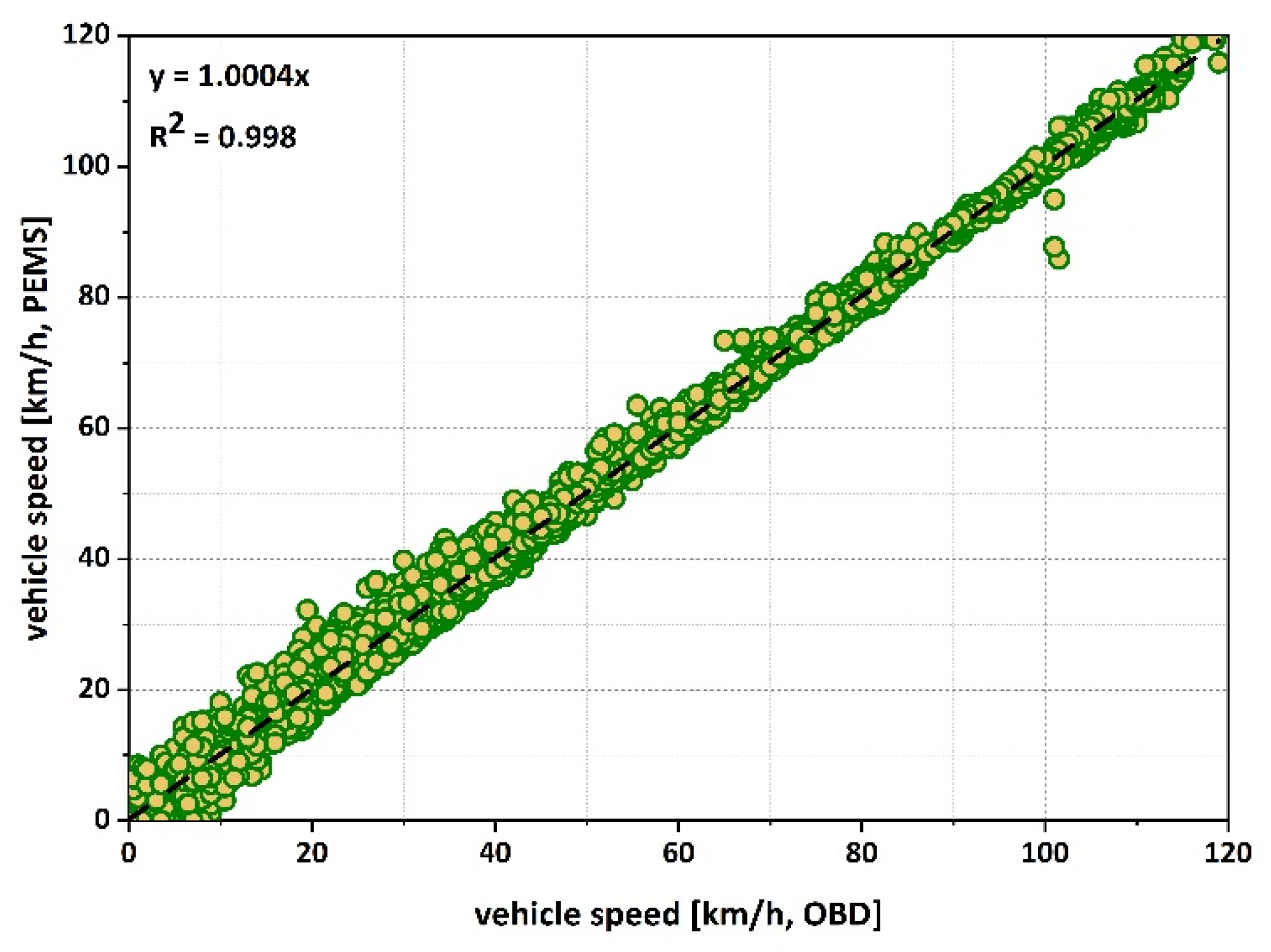

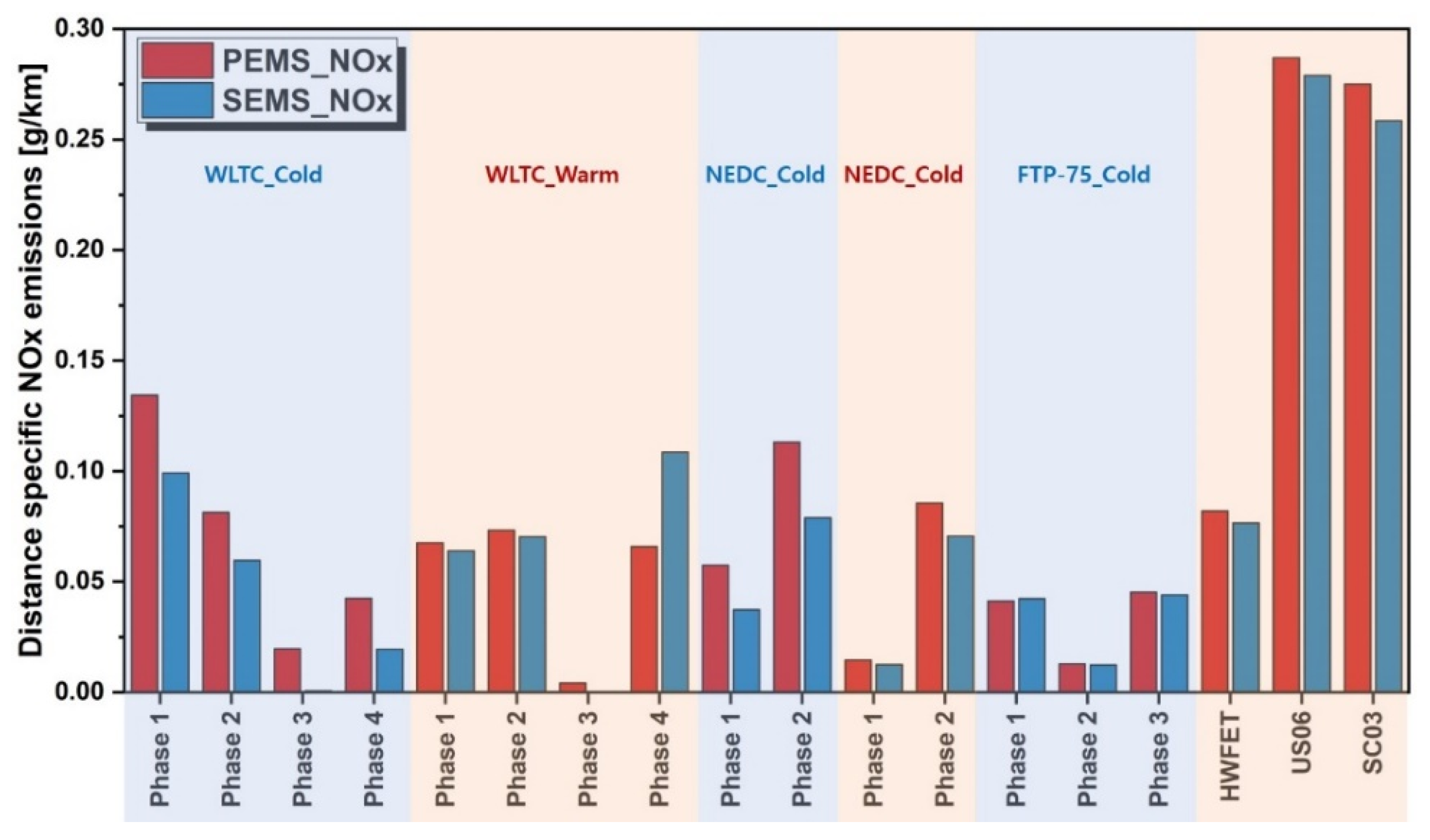
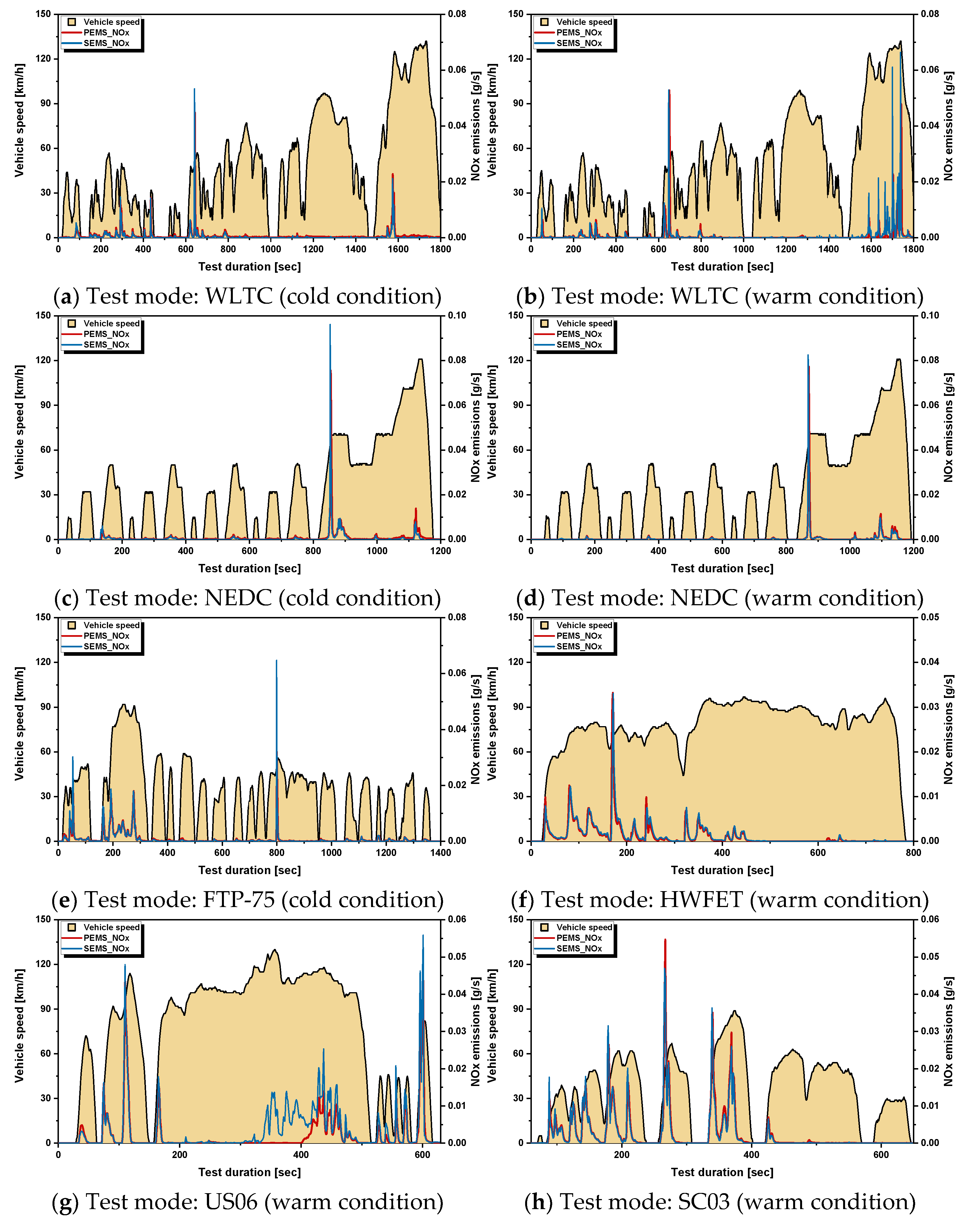


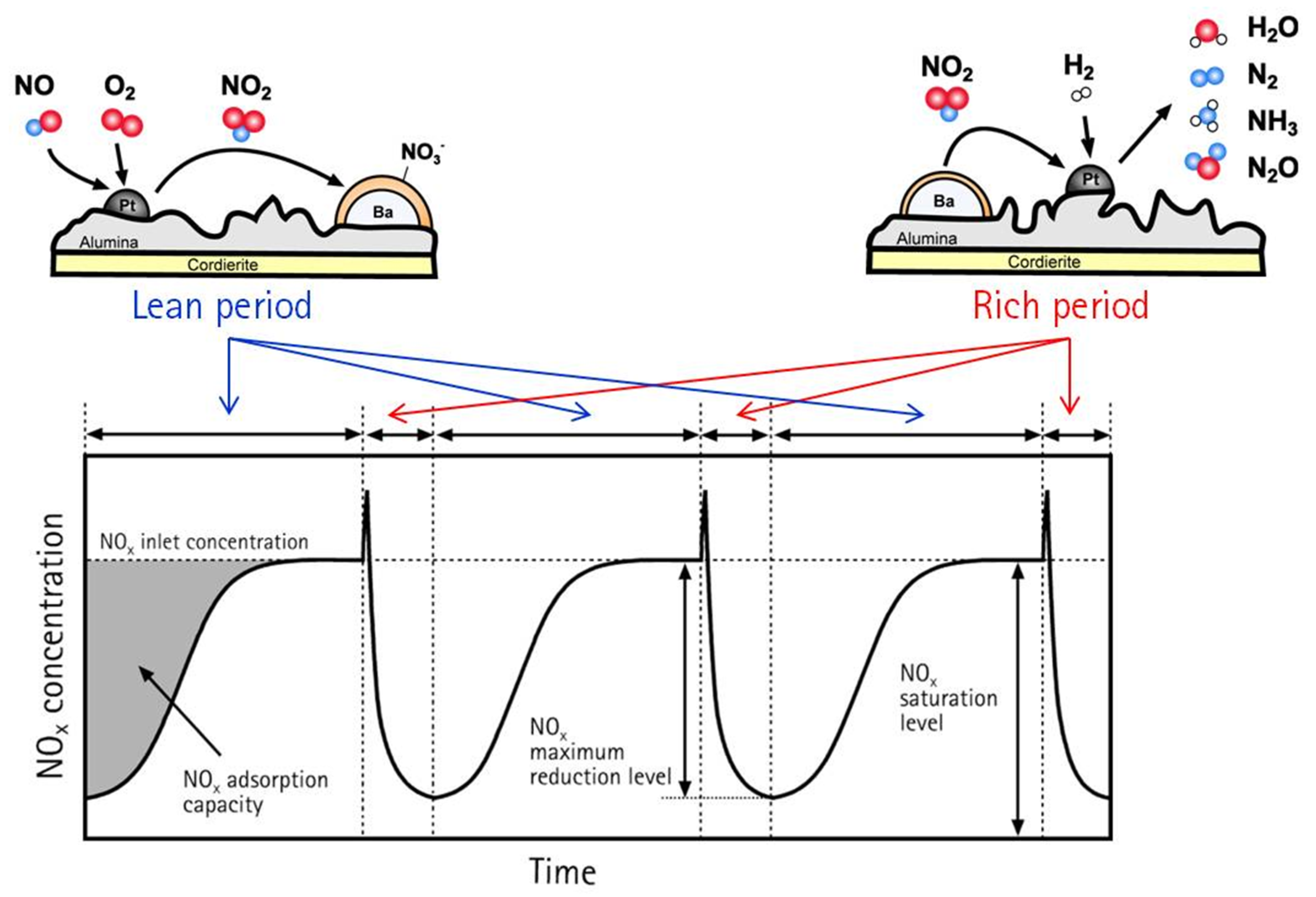
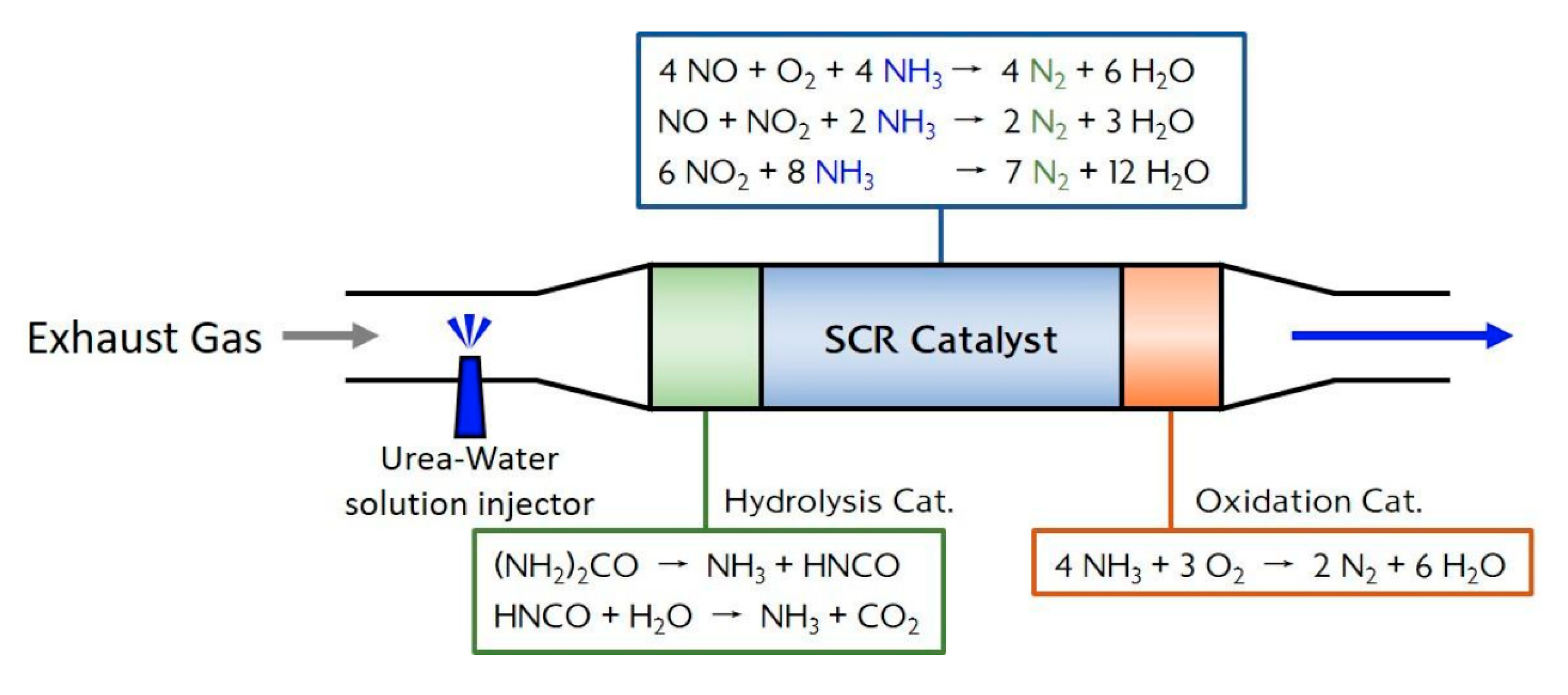
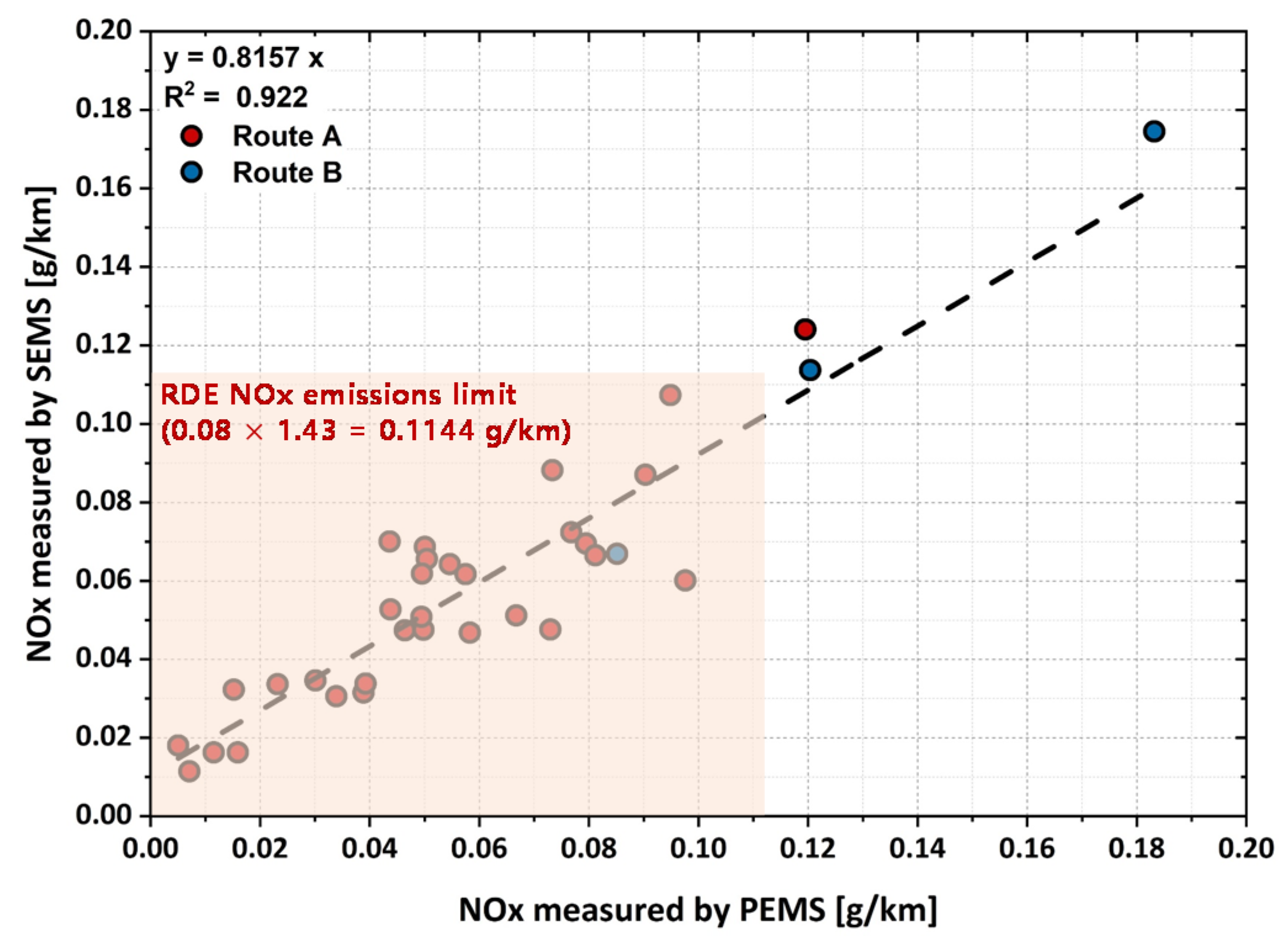
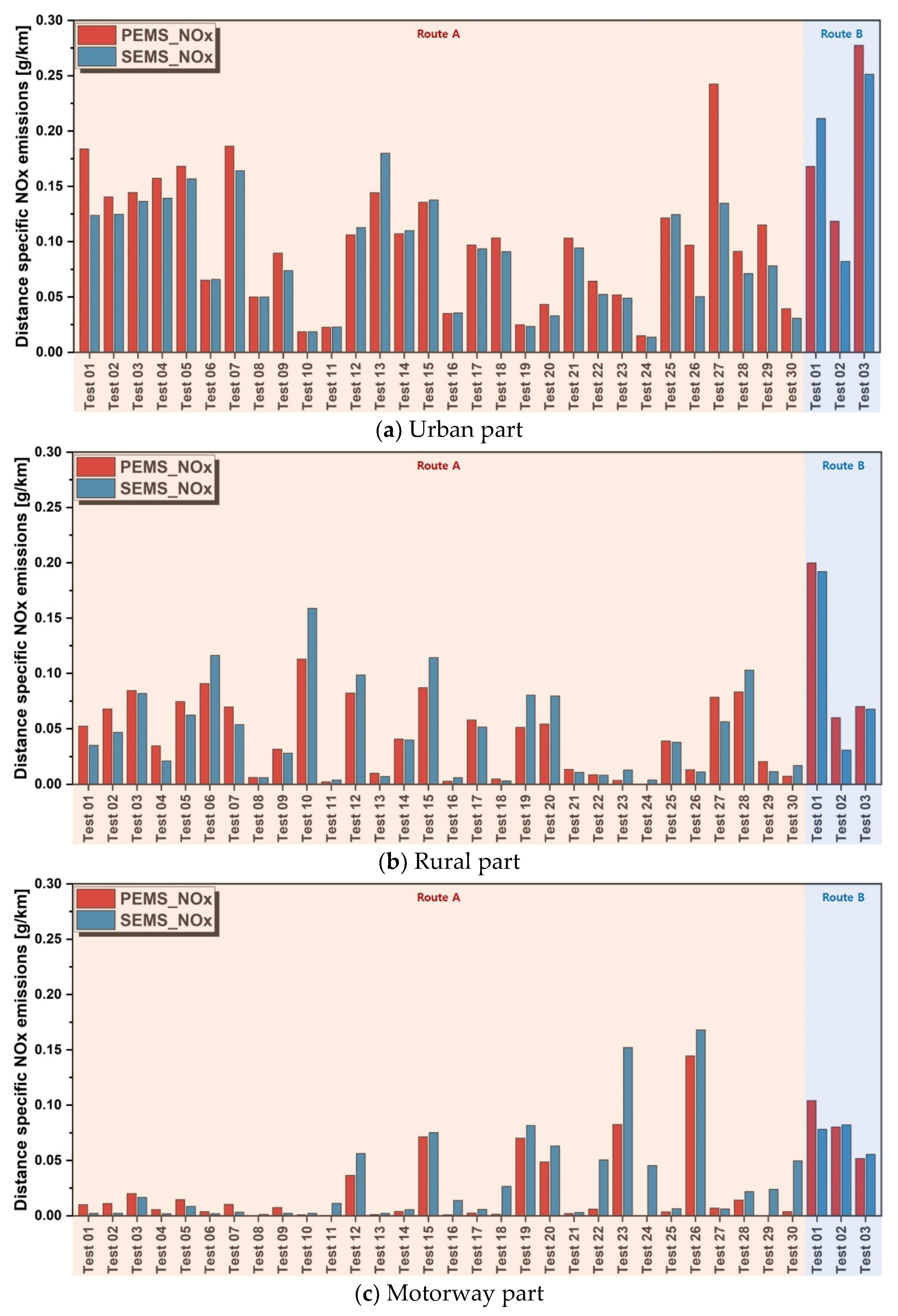
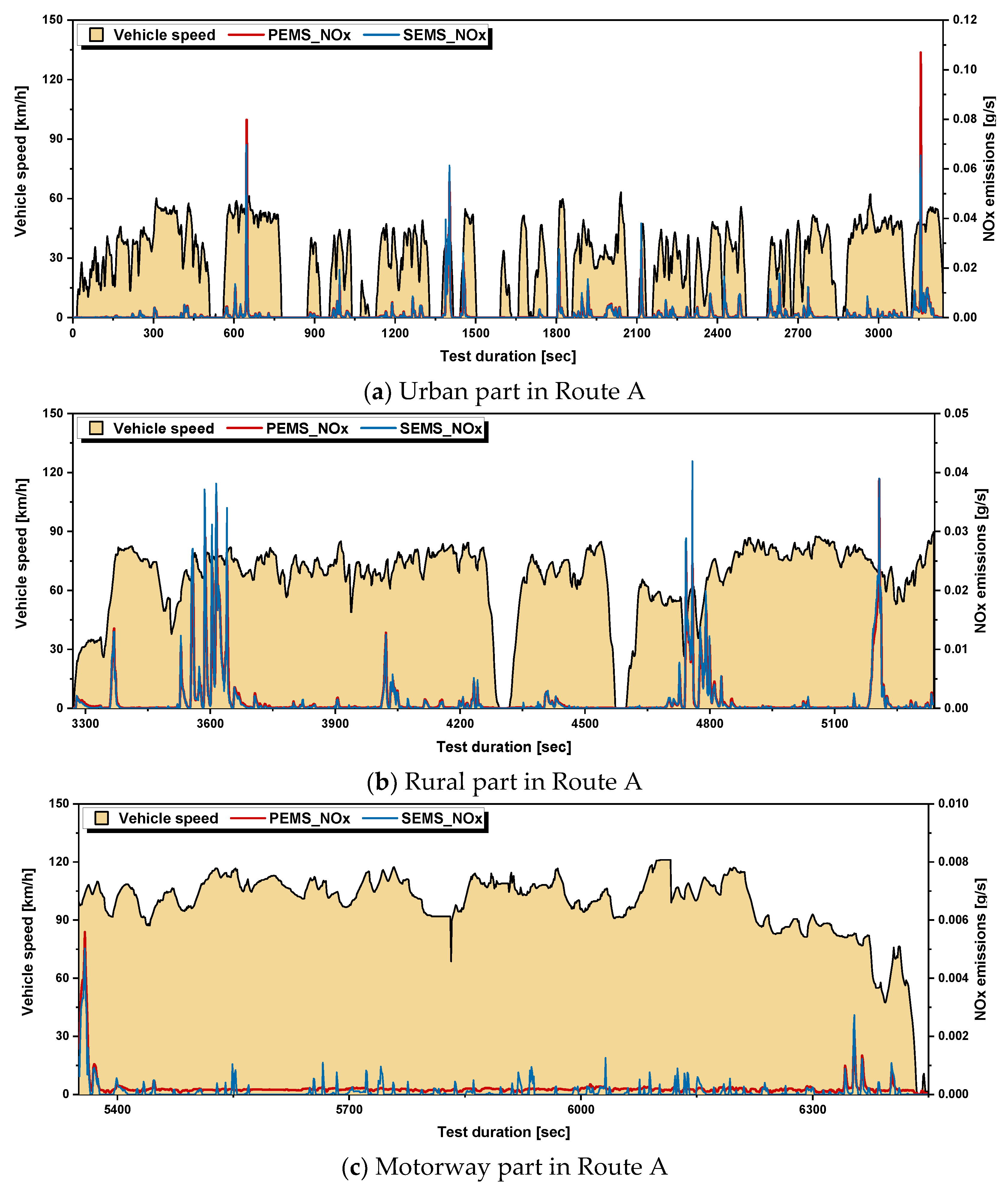
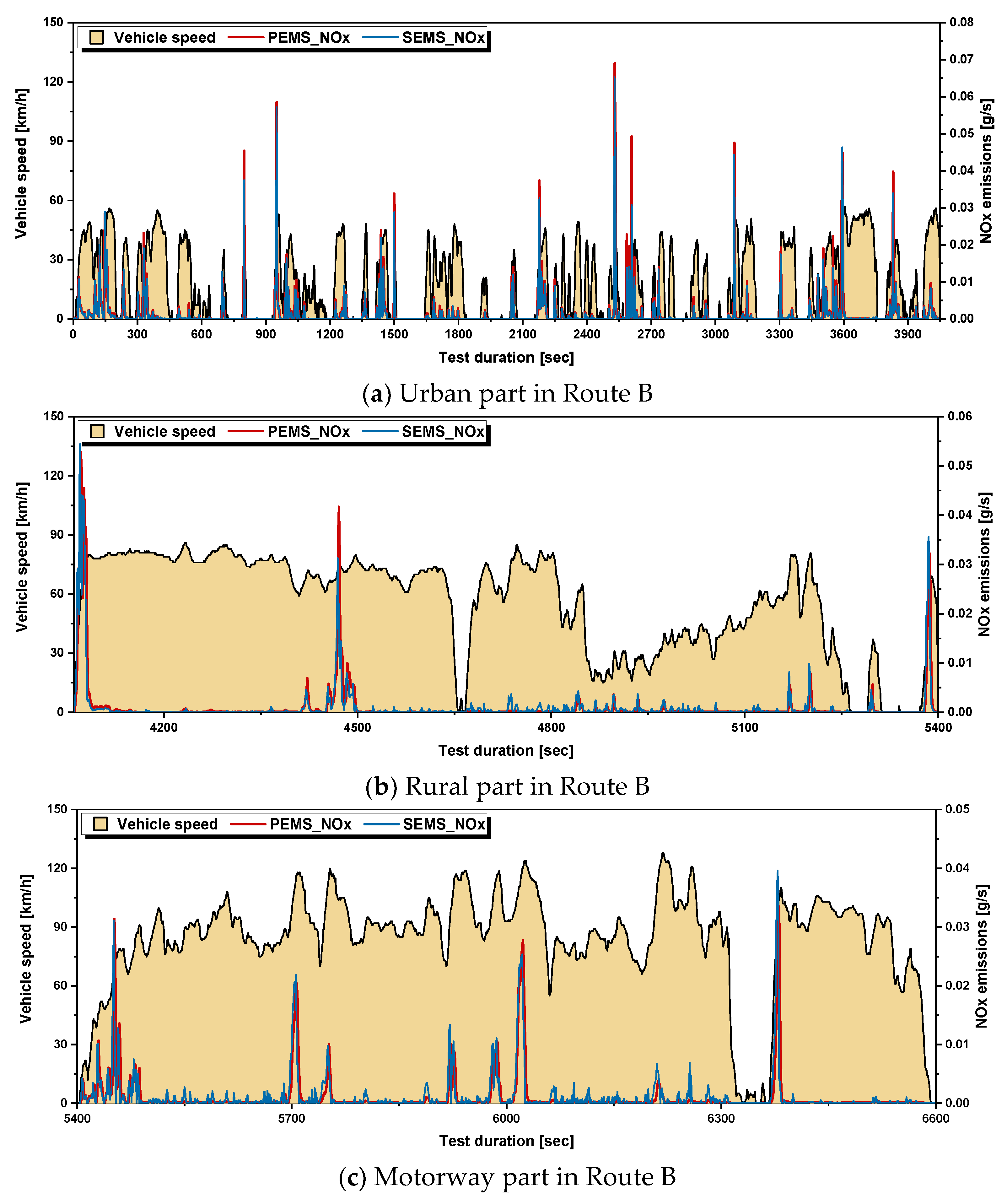
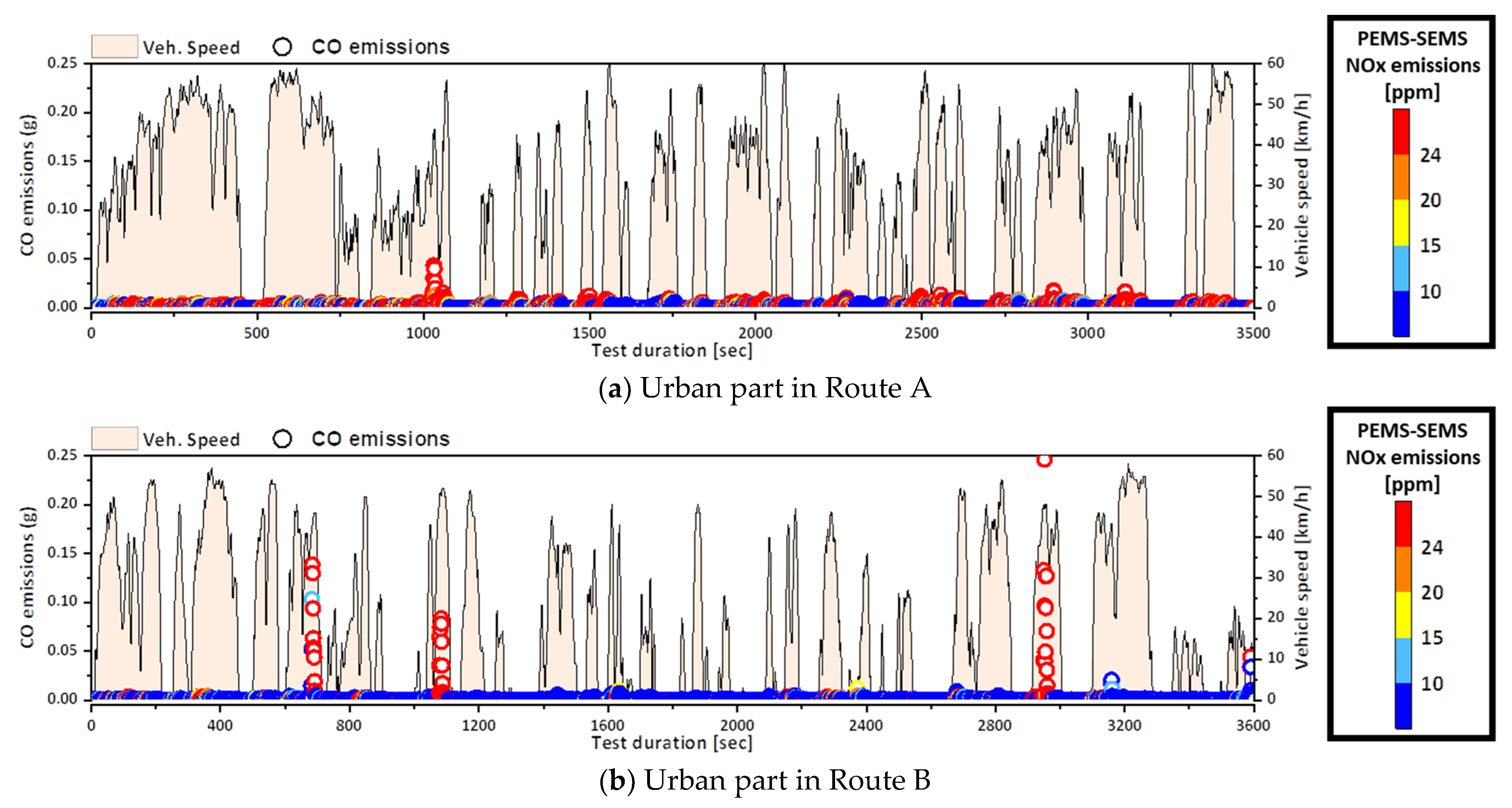
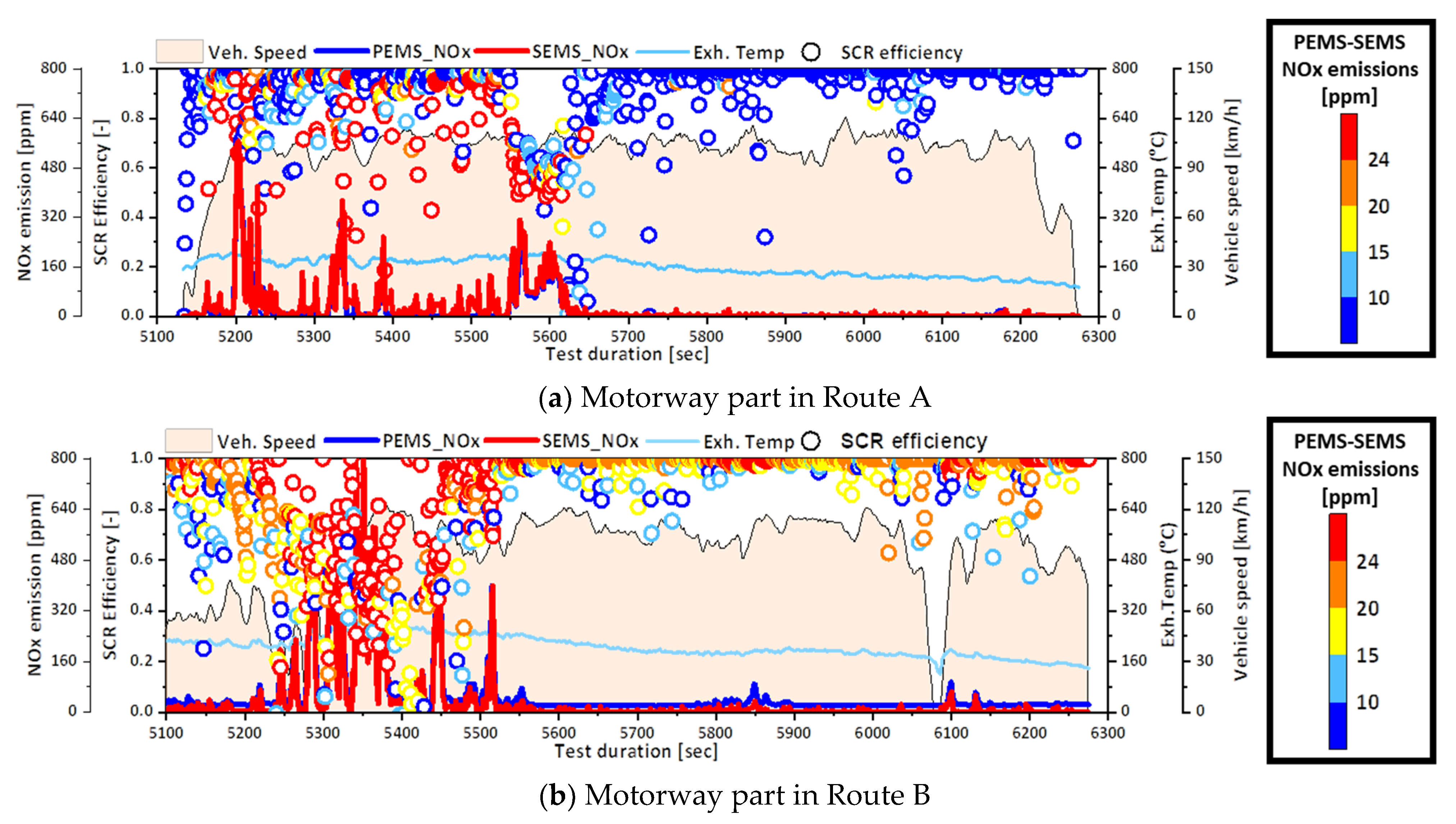
| Item | AVL |
|---|---|
| Roller | Single Roll 48 inch (MIM type) |
| Inertia weight range (kg) | 454–5448 |
| Maximum roll speed (km/h) | 200 |
| Electric motor absorber type | AC motor |
| Speed deviation | ±0.1% F.S. |
| Torque deviation | ±0.02 km/h |
| Driving distance measurement | Encoder |
| Cooling fan | Variable speed |
| Item | HORIBA |
|---|---|
| Constant volume sampler | CVS-7400T |
| Motor exhaust gas analyzer | MEXA-7200H |
| Dilution tunnel sampler | DLS-7100E |
| Dilution tunnel | DLT-1230 |
| Item | NEDC | WLTC | FTP-75 | HWFET | US06 | SC03 |
|---|---|---|---|---|---|---|
| Trip duration (s) | 1180 | 1800 | 1874 | 765 | 594 | 594 |
| Trip distance (km) | 11.03 | 23.27 | 17.77 | 16.45 | 12.87 | 5.79 |
| Avg. vehicle speed (km/h) | 33.6 | 46.5 | 34.1 | 77.7 | 77.9 | 34.1 |
| Maximum acceleration (m/s2) | 1.04 | 1.67 | 1.48 | 1.43 | 3.79 | 2.28 |
| Engine start condition | Cold Warm | Cold Warm | Cold | Warm | Warm | Warm |
| Vehicle 01 | |
|---|---|
| Type | SUV |
| Maximum power kW | 137 |
| Displacement cc | 1995 |
| Engine type | CRDI I4 |
| Model year | 2019 |
| Emission regulation | Euro 6d-temp |
| After-treatment | LNT + DPF + SCR |
| Urban | Rural | Motorway | Total | ||
|---|---|---|---|---|---|
| Route A | Trip distance (km) | 30.9 | 32.0 | 29.9 | 92.8 |
| Trip share (%) | 31.3 | 36.7 | 32.1 | 100.0 | |
| Trip duration (min) | 78.4 | 25.0 | 14.6 | 119.8 | |
| Average vehicle speed (km/h) | 26.4 | 77.6 | 107.9 | ||
| Route characteristics: stop duration of urban part is 23.79% | |||||
| Route B | Trip distance (km) | 22.0 | 23.0 | 21.4 | 66.4 |
| Trip share (%) | 33.1 | 34.7 | 32.2 | 100.0 | |
| Trip duration (min) | 59.1 | 17.5 | 13.9 | 90.5 | |
| Average vehicle speed (km/h) | 17.6 | 76.5 | 117.3 | ||
| Route characteristics: stop duration of urban part is 36.37% | |||||
| Principle | Specifications |
|---|---|
| Heated NDIR | CO: 0–8% vol. CO2: 0–18% vol. |
| Heated NDUV | NO: 0–3000 ppm NO2: 0–1000 ppm |
| Operating temperature (°C) | −10–45 |
| Tolerance of CO, CO2, NO, NO2 emissions | ±2% |
| Dimensions (mm) | SCS module: 435(W) × 410(D) × 105(H) GAS module: 437(W) × 312(D) × 135(H) EFM module: 365(W) × 105(D) × 90(H) |
| Weight (kg) | SCS module: 10.9 GAS module: 8.9 EFM module: 3.9 |
| Principle | Specifications |
|---|---|
| Measurement | ZrO2-based multi-layer sensor with integrated heater and three oxygen pumps |
| Output signals | NOx, linear or O2 concentration |
| Electrical system (V) | 12 |
| Operating temperature (°C) | 100–800 |
| Principle | Amperometric |
| NOx tolerance | 0–100 ppm: ±20 ppm 100–1500 ppm: ±20% |
| Measuring range | NOx: 0–1500 ppm : −0.994–1.010 |
Publisher’s Note: MDPI stays neutral with regard to jurisdictional claims in published maps and institutional affiliations. |
© 2021 by the authors. Licensee MDPI, Basel, Switzerland. This article is an open access article distributed under the terms and conditions of the Creative Commons Attribution (CC BY) license (https://creativecommons.org/licenses/by/4.0/).
Share and Cite
Yu, Y.S.; Jeong, J.W.; Chon, M.S.; Cha, J. NOx Emission of a Correlation between the PEMS and SEMS over Different Test Modes and Real Driving Emission. Energies 2021, 14, 7250. https://doi.org/10.3390/en14217250
Yu YS, Jeong JW, Chon MS, Cha J. NOx Emission of a Correlation between the PEMS and SEMS over Different Test Modes and Real Driving Emission. Energies. 2021; 14(21):7250. https://doi.org/10.3390/en14217250
Chicago/Turabian StyleYu, Young Soo, Jun Woo Jeong, Mun Soo Chon, and Junepyo Cha. 2021. "NOx Emission of a Correlation between the PEMS and SEMS over Different Test Modes and Real Driving Emission" Energies 14, no. 21: 7250. https://doi.org/10.3390/en14217250
APA StyleYu, Y. S., Jeong, J. W., Chon, M. S., & Cha, J. (2021). NOx Emission of a Correlation between the PEMS and SEMS over Different Test Modes and Real Driving Emission. Energies, 14(21), 7250. https://doi.org/10.3390/en14217250






